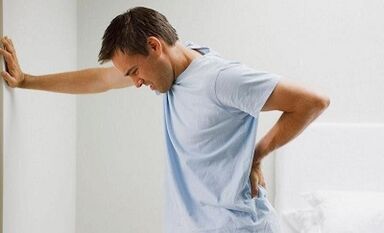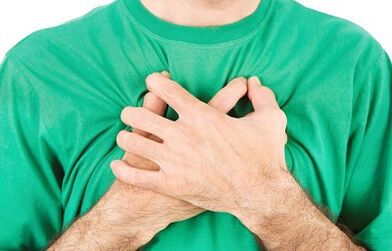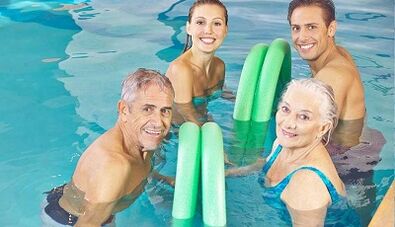
Lumbar osteochondrosis is a chronic damage to the lumbar spine that develops in the intervertebral discs as a result of many years of physical influences and metabolic disorders.Lumbar osteochondrosis has been shown to cause back pain in 75% of cases.
The lesion of the lumbar spine occurs in 60% of the inhabitants of the planet - this is the most common manifestation of osteochondrosis.The first signs of the disease appear at 20-30 years.
The danger of the disease is that in the shorter stages of the disease (when convexity (convexity) and hernia on intervertebral discs) occur, complications that require surgery, more special plantar fascia and inclination develop.
Lumbar osteochondrosis often complicates pregnancy.
Causes of lumbar osteochondrosis
The main cause of the disease is the systematic load on the lumbar spine and the metabolic disorders of the fibrous layer of the intervertebral discs.Raise weights, excess weight, constant physical work enhance the pressure on the column of the spinal animals.
Other causes of lumbar osteochondrosis: a sedentary and sedentary lifestyle, constant wearing high heels, malnutrition, consumption of small amounts of fluid, smoking, alcohol abuse.
When the protective muscle frame and the lack of treatment, the blood supply to the tissues worsens and the degenerative processes in the intervertebral discs worsen.As a result, the intervertebral discs do not receive enough blood supply - they lose elasticity, "dry", inflamed, flattened and protruding.
When protruding (convex), the spinal column of the spinal nerve is disturbed, which is manifested by pain at rest and during movements.Improper posture and injuries cause further uneven loading of the spine, which accelerates the development of lumbar osteochondrosis.
Stages of lumbar osteochondrosis
The peculiarity of the disease is the gradual development of degenerative processes.
Neurologists distinguish 4 stages of lumbar osteochondrosis:
- 1st stage& mbsp;Partial inflammation and flattening of intervertebral discs.It is manifested by burning in the lower back and stupid, not intense pain in the lower back.Unpleasant sensations occur after exercise, weight lifting.
- Stage 2- The distance between the vertebrae is reduced, the changes in the fibrous ring around the tissues are determined on the X -ray and a convexity of the discs occurs.The patient experiences acute pain in the lower back that gives (radiates) to the ass and legs.
- Stage 3- the appearance of intervertebral hernias due to the destruction of the fibrous vertebrae ring.At the 3rd stage, cartilage and vertebrae are intensively destroyed.The pain is permanent, they are felt even at rest.
- Stage 4- cartilage atrophy and intervertebral discs, accompanied by the pathological growth of bone tissue of the vertebrae and the formation of osteophytes.The pain occurs with every movement and every uncomfortable position of the body.The pain does not go on its own.These disorders require intensive treatment and lead to severe human damage.
Symptoms of lumbar osteochondrosis

In seventy percent of cases, doctors diagnose the disease in the second stage.During this period, the patient notes frequent periods of exacerbation with bright symptoms:
- The pain of low, which is exacerbated by physical exertion.With the development of degenerative processes, the pain becomes severe and constant;
- Restriction of movements.The movements are accompanied by increased pain with irradiation in the butt and legs;
- change in sensitivity in the lower limbs (numbness, burning, numbness);
- tension of the spinal muscles;
- Tingling and cold of the legs.
Diagnosis of osteochondrosis of lumbar
In 85% of cases, doctors diagnosed using radiography, computed tomography and magnet resonance (MRI).
The most comprehensive method is MRI.With their help, doctors determine the place and degree of damage to the lumbar spine.
The main task of the specialist is to distinguish osteochondrosis from Buscov's disease.
Complications of lumbar osteochondrosis
Lumbar Radiculitis or Roying Syndrome: The pathological process in the disorders of the spinal nerve (spine) is the most frequent complication of lumbar osteochondrosis.It occurs in 55% of cases.It is accompanied by pain and impaired sensitivity in the lower back and/or along the disturbed root.
In the short stages of the disease, a flattened intervertebral discs over the edge of the vertebrae occurs - a convexity occurs.When the fibrous ring is destroyed, an intervertebral hernia is formed.The interior hernia is an occasion for connecting a neurosurgeon.
In 40% of patients, the sciatic nerve is inflamed.This causes pain, numbness of the limb.As a result, the patient tolerates body weight to a healthy leg;The spine is even more aggravated, which exacerbates the severity of the disease.

10% of patients develop a narrowing of the spinal canal or compression myelopathy - squeezing the spinal cord.Requires surgical treatment.
The most common but dangerous complication is the "ponytail" syndrome - the defeat of several close nerve roots.
Every third patient with this complication has paralysis of paresis or legs.This also requires surgical treatment.
Treatment of lumbar osteochondrosis
It is impossible to cure lumbar osteochondrosis.You can eliminate the pain and slow down the degenerative processes in the vertebrae and disks.80% of the success in the treatment falls at 1 and 2 stages of the disease.
If there are no complications, neurologists cure osteochondrosis of the lumbar department with drugs, physiotherapy exercises, massage and physiotherapy.
Medicines are prescribed to exacerbate osteochondrosis to eliminate inflammation, pain and stimulation of metabolism in the vertebrae, cartilage, discs.
In acute pain, the therapeutic effect is achieved by intramuscular administration of drugs.Paravertebral blockade is prescribed for local anesthesia.Chondroprotectors are prescribed for 3-6 months.
The purpose of physiotherapy exercises is to strengthen the muscle of the back.Pool exercises are very useful.With lumbar osteochondrosis, exercises are performed after eliminating pain.Some doctors prescribe physiotherapy exercises even in pain, but this should be approached with caution.
Once the pain has disappeared, massage and reflexology courses are recommended.
Not complex lumbar osteochondrosis does not require frequent and multi -day stationary treatment.The disease is treated at home.They resort to folklore agents whose action is reduced to warming of the lower back.
Prevention of lumbar osteochondrosis
To prevent lumbar osteochondrosis, stick to simple rules:
- Follow the stand during many hours of stay in a stuck posture, change the position of the body;
- swim 3 times a week;
- Lift weight with two hands from a sitting position or, fixing (straightening) on your back;
- Avoid drafts;
- For a night break, choose an orthopedic mattress.


















